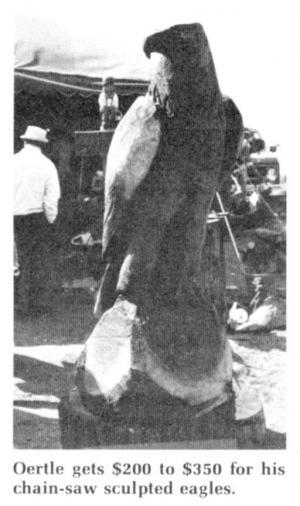Chain Saw Sculptors
 ✖  |
Rand E. Oertle has a job that lets him be a real "cut-up"! He's one of only a handful of fulltime chain saw sculptors in the country. You may have seen him, or one of the nine or so other professional chain saw sculptors in the U.S., at some of the farm shows around the country where chain saw sculpting has been drawing huge crowds.
As a full-time chain saw sculptor, Oertle works about 40 shows and fairs a year carving eagles, Indians, squirrels, rabbits and nearly anything else with his chain saw. He's been at it for 7 years, now.
Oertle works exclusively with the Stihl Chain Saw Co. Stihl furnishes him with saws and equipment and lines up the show dates. Oertle receives a fee for doing the show, plus whatever he can get for the sculptures he produces. For example, an eagle sitting in a perched position sells for $200 to $250. He also carves eagles with a spread-wing position that sells for $350. Smaller carvings go for $100 or less.
While some of the other chain saw sculptors start with the chain saw and finish up with a chisel, Oertle uses the chain saw all the way through. He uses whatever wood is available in the area he's working and has used walnut, cherry, redwood, cedar and pine the most. He notes that cedar is probably the easiest to work with.
Much of the finishing work Oertle does on a sculpture is done with the tip of the saw blade which makes kickback a potential problem. "I don't recommend anyone try this unless they're totally familiar with their saw and how it reacts in all situations," he explains. "You have to develop a 6th sense about potentially dangerous positions and be prepared at all times to react to a problem. It's a very physically demanding job. You've got to be strong enough to handle 6 to 7 hours of sawing a day in awkward positions with a heavy saw."
Here are some other tips Oertel offers anyone who wants to try chain saw sculpting: 1. Never carve when tired or ill. 2. Always make sure you have good footing. 3. Always be totally alert to dangerous situations. 4. Always wear hearing protectors and impact resistant glasses.
Oertle is also working on a book that Stihl is sponsoring that will detail, for potential chain saw sculptors, step-by-step instructions on how to create chain saw art safely and effectively.
For more details, contact: FARM SHOW Followup, Rand E. Oertle, Chain Saw Sculptor, 15975 Nauvoo Trail, Redding, Calif. 96001 (ph 916 244-1547).

Click here to download page story appeared in.
Click here to read entire issue
Chain Saw Sculptors SPECIALTY/SERVICES Specialty/Services 6-2-19 Rand E. Oertle has a job that lets him be a real "cut-up"! He's one of only a handful of fulltime chain saw sculptors in the country. You may have seen him, or one of the nine or so other professional chain saw sculptors in the U.S., at some of the farm shows around the country where chain saw sculpting has been drawing huge crowds.
As a full-time chain saw sculptor, Oertle works about 40 shows and fairs a year carving eagles, Indians, squirrels, rabbits and nearly anything else with his chain saw. He's been at it for 7 years, now.
Oertle works exclusively with the Stihl Chain Saw Co. Stihl furnishes him with saws and equipment and lines up the show dates. Oertle receives a fee for doing the show, plus whatever he can get for the sculptures he produces. For example, an eagle sitting in a perched position sells for $200 to $250. He also carves eagles with a spread-wing position that sells for $350. Smaller carvings go for $100 or less.
While some of the other chain saw sculptors start with the chain saw and finish up with a chisel, Oertle uses the chain saw all the way through. He uses whatever wood is available in the area he's working and has used walnut, cherry, redwood, cedar and pine the most. He notes that cedar is probably the easiest to work with.
Much of the finishing work Oertle does on a sculpture is done with the tip of the saw blade which makes kickback a potential problem. "I don't recommend anyone try this unless they're totally familiar with their saw and how it reacts in all situations," he explains. "You have to develop a 6th sense about potentially dangerous positions and be prepared at all times to react to a problem. It's a very physically demanding job. You've got to be strong enough to handle 6 to 7 hours of sawing a day in awkward positions with a heavy saw."
Here are some other tips Oertel offers anyone who wants to try chain saw sculpting: 1. Never carve when tired or ill. 2. Always make sure you have good footing. 3. Always be totally alert to dangerous situations. 4. Always wear hearing protectors and impact resistant glasses.
Oertle is also working on a book that Stihl is sponsoring that will detail, for potential chain saw sculptors, step-by-step instructions on how to create chain saw art safely and effectively.
For more details, contact: FARM SHOW Followup, Rand E. Oertle, Chain Saw Sculptor, 15975 Nauvoo Trail, Redding, Calif. 96001 (ph 916 244-1547).
To read the rest of this story, download this issue below or click
here to register with your account number.







